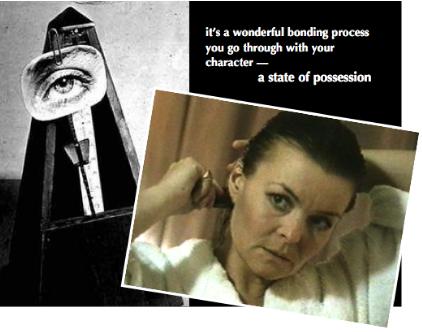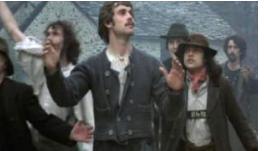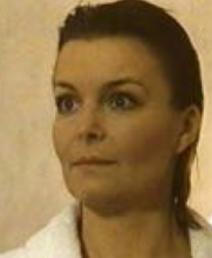![]()
 Most people go unaware that periodically throughout the day, they move in and out of natural trances states where the mind wanders, and memories flow easily. Others may feel uncomfortable and try to suppress what Rossi calls "personal truths that come unbidden during these naturally unguarded periods." Some people become so entranced that they neither see nor hear their immediate surroundings. They enter a hypnoid state which is similar to that of great acting.
Most people go unaware that periodically throughout the day, they move in and out of natural trances states where the mind wanders, and memories flow easily. Others may feel uncomfortable and try to suppress what Rossi calls "personal truths that come unbidden during these naturally unguarded periods." Some people become so entranced that they neither see nor hear their immediate surroundings. They enter a hypnoid state which is similar to that of great acting.
Psychologist, John Rowan, has likened Method acting to the installation of a sub-personality:
“Stanislavsky in his famous work An Actor Prepares, is really quite often giving instructions as to how to set up an inner sub-personality corresponding to the character in the play. One of the definitions of Method acting might be, that form of acting which depends upon sub-personalities for its success.“ (31)
One of the definitions of a subpersonality is "a complex of thoughts, feelings and even body sensations which is capable of acting as a complete person for shorter or longer periods of time". 22. From this point-of-view, an actor’s submergence in a role is much the same thing as an hysteric being taken over by a sub-personality. The crucial difference is that the actor retains the ability to step in and out of this sub-personality at will, whereas the hysteric does not.
"I seem to have an awful lot of people inside me. Do you know what I mean? I understand them, I feel terribly like them when I'm doing them ... by thinking you turn into the person if you think strongly enough. It's quite odd sometimes, you know. You are it for quite a bit, and then you're not ..." (4)
Edith Evans
We may liken the relationship of actor in performance and the character role he plays to that of channelling. This is a word often used to denote communication with "spirit entities" and the like, but channelling can equally take place on a purely psychological level. This is what happens when we find ourselves unconsciously speaking in our father's tone of voice. And for the actor, who has formed an intimate relationship with the character that they are playing, this can happen in a more expansive and fluid way
 Alice Englert spoke to Sally Potter about tuning out her real-life identity like turning the dial on a radio.
Alice Englert spoke to Sally Potter about tuning out her real-life identity like turning the dial on a radio.
“I always think that I'm the white noise in the scene ... it's like tuning out. You're in the scene and I then hear, 'Cut,' and for me it's almost like, 'Oh, I'm Alice.' “(29)
Similarly Elle Fanning described her process:
“I rely a lot on my senses. Just focusing in and blocking everything out, but also taking everything in at the same time ... It's like an out-of-body experience, because you're not looking at yourself. You do later, when the movie comes out, but at the time you’re not. You have to look inside yourself so much that it feels like you're looking down at yourself.” (29)
Occasionally this trance-like state can reach a depth akin to that state of immunity that renders men capable of walking on fire or putting skewers through their cheeks while feeling no pain.
"... when there's film going through the gate. That's it. I hear that noise and nothing hurts anymore. they could pound nails through me and I wouldn't feel it. I've had terrible injuries in the middle of a take, and not felt them until they say. "Cut", and I fell over. I had a guy kick me and not feel it. It's a weird high." (2)
Mel Gibson
Many have previously been struck by the trance-like quality of actors during performance. The director, Werner Herzog, on his film, Heart of Glass, went one step further. He had his entire cast, (other than the lead actor), inducted into trance by an on-set professional hypnotist. However, all that this proved was that, either hypnotised people cannot act, or, perhaps, they can act only people who are hypnotised . The few NLP practitioners who have turned their attention to acting, such as Brian David Phillips (www.briandavidphillips.net), Nick Dunning (http://nlp-for- actors.com) or Robert Barton of in his book, Acting Reframes (3), have produced very underwhelming results. The problem is that, beyond bolstering confidence for auditions, they have very little to add to the processes that the best actors already use intuitively.
![]()
 The usual idea of hypnotic trance is of someone whose ego control has been replaced by the commands of a hypnotist. The creative trance through which an actor’s performance is forged, however, is self-generated through the process of weaving together the fragments of felt experience that spontaneously appear relevant to the character role that they are in the process of creating. It is a state of deep absorption similar to that which we enter when we suspend disbelief and become engrossed in reading a novel or watching a movie. For the actor this goes one step beyond, to a highly creative state where they are open to their own subconscious resources. It is an experience of flow like that of an athlete who speaks of “being in the zone.” And for the actor, when a performance soars he may have the experience of being taken over — or possessed — by the character he is portraying.
The usual idea of hypnotic trance is of someone whose ego control has been replaced by the commands of a hypnotist. The creative trance through which an actor’s performance is forged, however, is self-generated through the process of weaving together the fragments of felt experience that spontaneously appear relevant to the character role that they are in the process of creating. It is a state of deep absorption similar to that which we enter when we suspend disbelief and become engrossed in reading a novel or watching a movie. For the actor this goes one step beyond, to a highly creative state where they are open to their own subconscious resources. It is an experience of flow like that of an athlete who speaks of “being in the zone.” And for the actor, when a performance soars he may have the experience of being taken over — or possessed — by the character he is portraying.
However, the actor always has to keep some degree of control. Unlike the slumped bodies or zombie-like movements of subjects under classical hypnosis, the actor has to keep awareness that he is on a set with certain restrictions, he has to hit marks, react to cues, etc. So there is always a balance to be struck between submergence in the fictional world and awareness of the artful means of portraying that world. And this is not just something with which the actor must cope, but also, in film, something that the director must factor into his calculations.
 For example; in Bookie there was a scene in which the widow of a compulsive gambler, played by Isla Blair, is visited by a bookie who was a friend of her husband’s, played by Maurice Roëves, shortly after she has discovered that, not only did her husband commit suicide but that he has left her a backlog of debts which she has no means to pay. She begins the scene with a stream of bitter asides which builds into an hysterical tirade before she collapses distraught into the bookie’s arms. While this was a very long scene, that played almost as a monologue but for brief interruptions, I knew that to break it down into shots in the usual way would simply kill it. Emotion runs it’s own course with it’s own timing and cannot just be cut into at will. Despite the stress put on both Isla and the camera team it was clear that the main body of the scene would have to be shot in one.
For example; in Bookie there was a scene in which the widow of a compulsive gambler, played by Isla Blair, is visited by a bookie who was a friend of her husband’s, played by Maurice Roëves, shortly after she has discovered that, not only did her husband commit suicide but that he has left her a backlog of debts which she has no means to pay. She begins the scene with a stream of bitter asides which builds into an hysterical tirade before she collapses distraught into the bookie’s arms. While this was a very long scene, that played almost as a monologue but for brief interruptions, I knew that to break it down into shots in the usual way would simply kill it. Emotion runs it’s own course with it’s own timing and cannot just be cut into at will. Despite the stress put on both Isla and the camera team it was clear that the main body of the scene would have to be shot in one.
Of course, scenes like this are the exception; most do not require this depth of absorption. However, those enacted on a more conscious level can still flow with the same quality of truth; but only when the actor has in preparation gone through that “wonderful” subconscious process of bonding with the character, that state of possession, that Jude Law pointed up:
“It’s a wonderful bonding process you go through with your character; a state of possession.” (29)
Jude Law